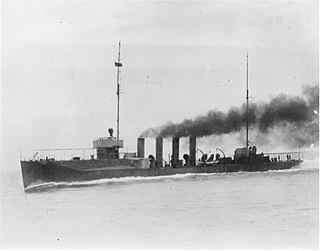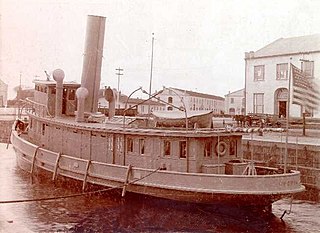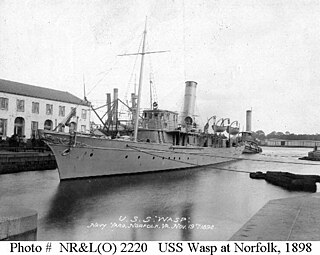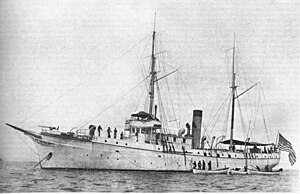
The first USS Minneapolis (C-13/CA-17) was a United States Navy Columbia-class protected cruiser. She was named for the city of Minneapolis, Minnesota.

The first USS Radford (DD–120) was a Wickes-class destroyer in the United States Navy during World War I, later reclassified AG-22. She was named for William Radford.

The second USS Marblehead (C-11/PG-27) was a Montgomery-class unprotected cruiser in the United States Navy, authorized in the naval appropriations bill of September 7, 1888. Marblehead served in the Spanish–American War and World War I, and was the last ship of her class in service.

The O'Brien class of destroyers was a class of six ships designed by and built for the United States Navy shortly before the United States entered World War I. The O'Brien class was the third of five classes of destroyers that were known as the "thousand tonners", because they were the first U.S. destroyers over 1,000 long tons (1,016 t) displacement.

USS Winslow was an O'Brien-class destroyer built for the United States Navy prior to the American entry into World War I. The ship was the second US Navy vessel named in honor of John Ancrum Winslow, a US Navy officer notable for sinking the Confederate commerce raider CSS Alabama during the American Civil War.

USS Hatfield (DD-231/AG-84) was a Clemson-class destroyer in the United States Navy during World War II. She was named for John Hatfield, killed in action 1813. As of 2005, no other ship of the U.S. Navy has been named Hatfield.

The fourth USS Montgomery (C-9), the lead ship of her class, was an unprotected cruiser in the United States Navy authorized in the Naval Appropriations Act of September 7, 1888. Montgomery served during the Spanish–American War and in World War I and was named for Montgomery, Alabama.

USS Dorothea, a civilian vessel that retained her original name when purchased by the Navy for use as a gunboat, was the only ship of the United States Navy to bear that name, though other ships have been named Dorothea L. Dix, Dorothy Cullen, and Dorothy.

USS Gloucester was a gunboat in the United States Navy. She was built in 1891 as the yacht Corsair II for J. P. Morgan by Neafie & Levy of Philadelphia, to a design by John Beavor-Webb. The yacht was acquired by the Navy on 23 April 1898 and commissioned Gloucester on 16 May 1898 with Lieutenant Commander Richard Wainwright in command.

USS Hawk (PY-2/IX-14) was the converted British-built civilian yacht Hermione of 1891, acquired for service as a patrol yacht in the Spanish–American War. She later served in the Ohio and New York naval militias and on the Great Lakes until decommissioned in 1940.

The second USS Puritan was a Puritan-class monitor in the United States Navy, constructed in 1882. She was the only ship in her class.

USS Winslow was a United States Navy torpedo boat noted for its involvement at the First and Second Battle of Cardenas during the Spanish–American War. She was named for Rear Admiral John Ancrum Winslow.

USRC Hudson, known for her service during the Battle of Cárdenas, was the United States Revenue Cutter Service's first vessel to have a steel hull and triple-expansion steam engine.

The second USS Rodgers was a United States Navy torpedo boat, laid down by the Columbian Iron Works & Dry Dock Co., Baltimore, Maryland, on 6 May 1896; launched on 10 November 1896; and commissioned on 2 April 1898, Lt. Joseph Lee Jayne in command. It was named after John Rodgers as well as John Rodgers.

The first USS Du Pont was launched 30 March 1897 by Herreshoff Manufacturing Co., Bristol, R.I.; sponsored by Miss L. Converse; and commissioned 23 September 1897, Lieutenant Spencer S. Wood in command.

USS Sandoval (1895) was an Alvarado-class gunboat acquired by the United States Navy from the Spanish as a prize-of-war. Duties assigned her by the Navy included patrolling coastal and river waterways, and, later, acting as a "practice ship" for the United States Naval Academy at Annapolis, Maryland and for the New York Naval Militia as well.
USS Alvarado (1895) was a gunboat captured from the Spanish Navy during the Spanish–American War, and then commissioned for use as a United States Navy gunboat. After the war was over, she was again commissioned for use as a training ship for the United States Naval Academy and the Louisiana Naval Militia.

The seventh USS Wasp was the former yacht Columbia, purchased by the U.S. Navy and converted to an armed yacht serving from 1898 to 1919, with service in the Spanish–American War and World War I.

Soon after the United States entered World War I, Actus (SP-516) — a yacht constructed in 1907 at Neponset, Massachusetts, by George Lawley & Sons — was taken over by the US Navy as a section patrol craft from Mr. E. B. Dane; commissioned on 1 April 1917, with Ensign H. A. D. Cameron, USNR, in command; and, on 26 May 1917, over a month later, formally purchased by the Government.
HMS Kingsmill (K484) was a British Captain-class frigate of the Royal Navy in commission during World War II. Originally constructed as the United States Navy Evarts-class destroyer escort DE-280, she served in the Royal Navy from 1943 to 1945 and then in the U.S. Navy as USS Kingsmill (DE-280) from August to October 1945.


















